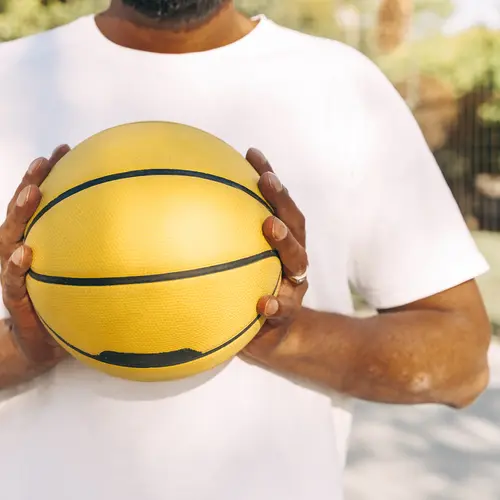Varicose veins are swollen or enlarged veins that run just under the skin's surface, usually on the legs and feet. They form when the valves on the veins become weak or damaged. This condition affects about 25% of women and 15% of men.
You may be at a higher risk for varicose veins if you are older, lead an inactive lifestyle, or sit or stand for long periods, or if you have obesity. Varicose veins can also be hereditary, or they can develop after a trauma or an injury. They are also common for many women during pregnancy. Being physically active can help improve blood flow and vein health.
With any type of exercise, it's best to start slowly, then increase your activity when you feel comfortable. High-impact exercises like jogging and jumping can increase blood pressure in the legs, which can feel uncomfortable. If you begin carefully and work up to incorporate more activity, exercises can both reduce your risk of developing, or developing more, varicose veins, and it can improve your overall circulation, which should help with the pain associated with varicose veins.
Exercises to Help Varicose Veins
If you have varicose veins, exercise can’t cure them, but it can ease your discomfort. While there is no way to completely prevent varicose veins, exercise will improve circulation and tone your muscles, which may reduce your likelihood of developing them. Getting rid of existing varicose veins can be trickier. While in some cases, more advanced treatments — ranging from minimally invasive to more complicated surgeries to remove the veins — may be needed, beginning with self-care treatments, including compression stockings and regular exercise, is a great place to start to ease pain and keep existing varicose veins from getting worse.
Walking is a low-impact exercise that helps improve calf muscle pump action. Doctors recommend walking every day. Try to walk for about 30 to 45 minutes. You can do this as many times a day as you like.
The movements in swimming push your legs up and stop blood from pooling in them. Swimming is a great low-impact cardio exercise, because it doesn’t require your joints and bones to bear your weight. If you’re new to swimming but have access to a pool, you can start easy by trading off 30 seconds of activity and 30 seconds of rest. You can shake things up by focusing on your kicking with a kickboard or trying out full strokes. As you get more comfortable, you can increase your time swimming or the number of laps you’re doing, but try these increases in small inverals — no more than a 10% increase week to week.
Cycling or Bicycle Legs
Cycling, whether outdoors or on a stationary bike, can be helpful. Like walking, cycling can improve muscle strength in your calves, and like swimming, it’s a low-impact activity that isn’t as load-bearing for your legs. If you’re cycling, you’ll want to keep a close eye on your duration and your posture though, because long cycling sessions bent over handlebars can reduce blood flow to your legs. If you don't have a bike, lie on your back with your legs raised and bent. Then pedal in the air like you're riding a bike.
Doing yoga can help as some poses elevate your legs above your heart and help improve circulation. Yoga involves stretching and holding poses while focusing on your breathing. Incorporating simple stretches and working up to more challenging poses can help you start and keep moving.
One pose in particular, the “Viparita Karani,” in which you put your feet up on the wall and let gravity work to increase blood flow, might be a particularly good fit for vein health. Here’s how to try it:
Step 1: Lie on the floor with one shoulder near a wall.
Step 2: Turn your body and walk your feet up the wall until they're at a right angle to the ground.
Step 3: Position your body so that your bottom is against the wall.
You can make this pose more comfortable with a pillow under your head
Rebounding
Rebounding, or jumping up and down on a mini trampoline, can help reduce blood pooling in your legs. Do this for five minutes, three times a day.
Leg Lifts
Doing a few sets of leg lifts is an easy exercise to incorporate into your at-home routine, and it will help stretch your leg muscles.
Step 1: Lie on your back with your feet straight out.
Step 2: Lift one leg and hold it in the air for a few seconds.
Step 3: Slowly lower your leg.
Step 4: Repeat with the other leg
Repeat several times with each leg.
Ankle Rotations
Moving and stretching your ankles is a good exercise if you have to sit for a long time. This can encourage the blood to keep flowing through your legs and into your feet and back, improving your overall lower-body circulation.
Step 1: Rotate your feet at the ankles, making small circles.
Step 2: Do the rotations in the opposite direction.
Repeat several times.
Calf Raises
Doing simple sets of calf raise exercises improves blood circulation, too, which is great for helping varicose veins.
Step 1: Stand straight with your feet hip-width apart. You can hold onto a chair or wall for balance.
Step 2: Slowly raise your heels up off the floor until you are standing on your tiptoes. Hold.
Step 3: Slowly lower your heels.
Repeat several times.
Safety Considerations
While it’s always a great idea to increase your daily activity, flexibility, and circulation, it’s good to keep in mind that some high-impact exercise could make varicose veins worse. If you notice your pain gets worse after trying any of these exercises, talk to your doctor.

